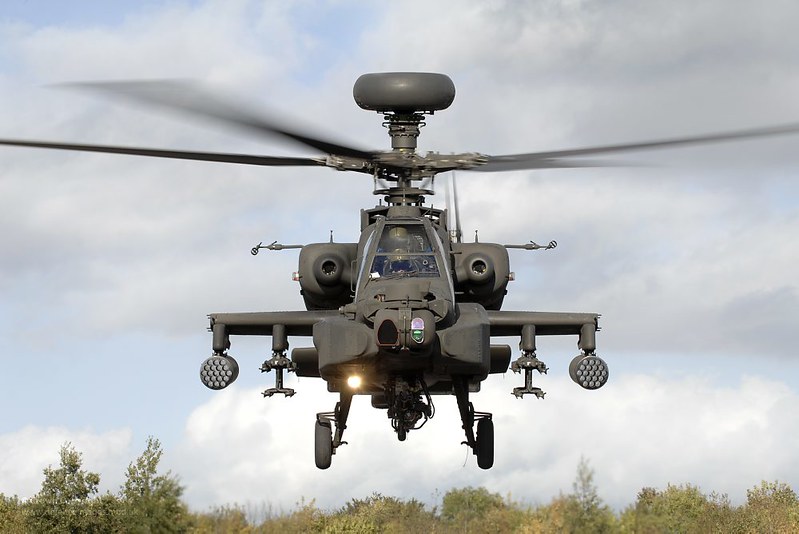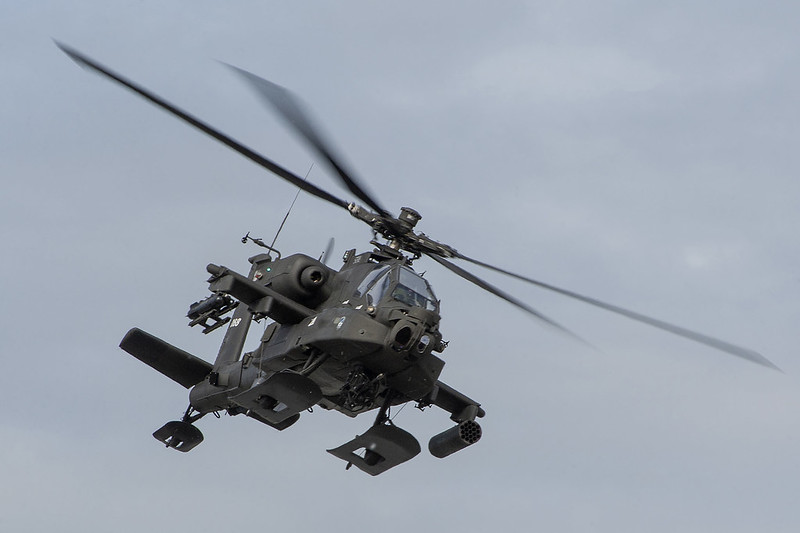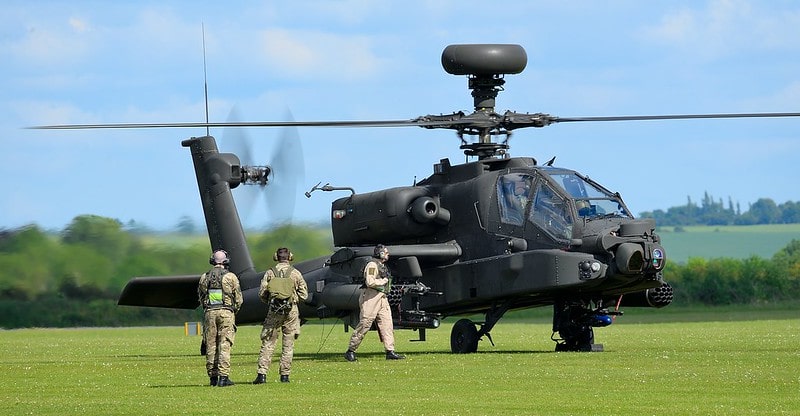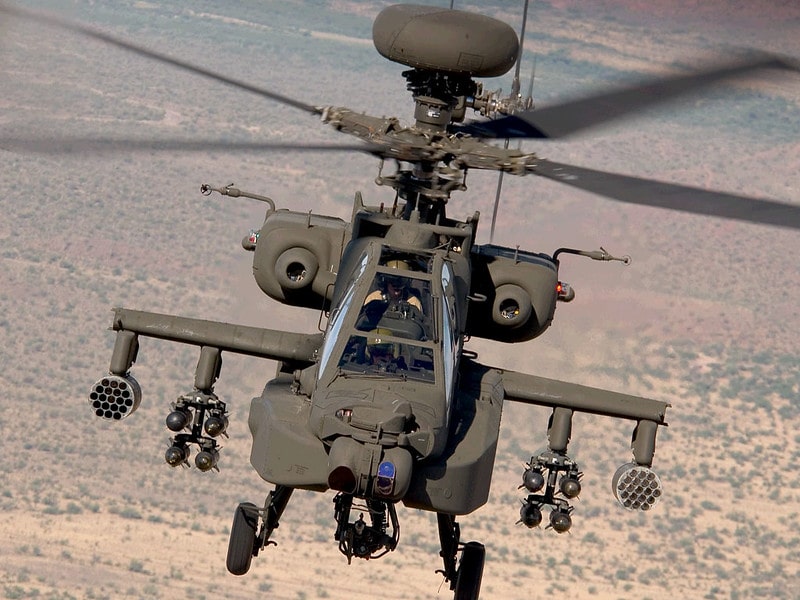Boeing’s AH-64 Apache helicopters are the most advanced war machines and the backbone of the US Army attack helicopter fleet and many other Air Forces around the world.
According to Boeing, “with unprecedented performance, advanced sensors and connectivity forming the building blocks of this fully integrated platform, the AH-64E Apache stands as the world’s most advanced multi-role combat helicopter.”
The first prototype YAH-64 Apache helicopter was developed by Hughes Helicopters for the US Army under the Advanced Attack Helicopter program in 1975. The Hughes Helicopters was sold to McDonnell Douglas (now Boeing) in 1984. The new attack helicopter was inducted into the US Army in 1986.
Follow us on Google News to get the latest defense news and analysis
The US Army has more than 800 Apache helicopters currently in service. It was first used by the US Army in the operation in Panama in 1989. Then onwards it was extensively used in different combat operations around the world by the US Army and other air forces.
Boeing until 2020, has delivered more than 2400 Apache helicopters to the air forces around the world. According to the data provided by Boeing on its official website, the helicopter has accumulated more than 4.5 million flight hours.

Apache helicopter features:
The AH-64 Apache is a twin turboshaft attack helicopter with a tandem seat for a crew of two. The new upgrade to the engines having the face gear transmission to accommodate more power.
The helicopter has a length of 14.68 m and a height of 4.72 m. The maximum operating weight is 10,432 kg. The maximum rate of climb of the Apache is 853+ meters (2800+ feet) per minute. The maximum service ceiling of 20,000 feet.
Variants of Apache helicopter:
The Apache has been built using the block building approach. This means its older versions can be upgraded to the latest one without being made major changes in the body or the airframe. Until now Boeing has developed the five variants of the Apache helicopter. These include,
- AH-64A
- AH-64B
- AH-64C
- AH-64D
- AH-64E
AH-64A:
The AH-64A is the original production attack helicopter. It was powered by two GE-T700 turboshaft engines. The US Army’s AH-64As were converted to the AH-64Ds variant in 2013.
Boeing has produced 937 AH-64A variants between 1984 to 1997. Some of these units are still in service with different air forces.
AH-64B:
In 1991, the AH-64As were proposed to be upgraded to the new version through an improved navigation system to GPS, new rotor blades, and new radios. The B variant upgrade was canceled in 1992 and the modifications were installed through other upgrades.
AH-64C:
All the upgrade plans of the previous variant were included in the C version of Apache. The ‘B and C’ variants of the Apache helicopter are not being implemented and the upgrades after the ‘A’ variant was ultimately shifted to the ‘D’ variant of the Apache attack helicopter.
AH-64D:
All the previous versions of the Apache helicopters including the AH-64C were upgraded to the ‘D’ variant. The AH-64D has a lot more new features than the older variants of the helicopter.
The AH-64D is also known as the ‘Apache Longbow’. The helicopter has AN/APG-78 Longbow millimeter-wave fire-control radar (FCR) target acquisition system and the Radar Frequency Interferometer (RFI) housed in a dome located above the main rotor. The new radar AN/APG-78 used in this version of Apache can track simultaneously up to 128 targets and engage up to 16 at a time.
It includes all-weather, day/night fighting capability, longer-range weapons accuracy, detection of stationary or moving targets without being detected, and identification and prioritization of up to 128 targets in less than a minute.
This version of the Apache helicopter also has advanced networking capabilities for situational awareness, integrated sensors, digital communication system, real-time combat management system, and digital transmission of images and target locations to battlefield commanders.
AH-64E:
The AH-64E ‘the Guardian’ is the most advanced variant of the Apache to date. With its advanced multi-role capabilities, its numbers are growing rapidly due to an increase in its demand by air forces around the globe. Boeing has delivered more than 400 models of AH-64E worldwide.
According to Boeing, the AH-64E includes a Joint Tactical Information Distribution System, advanced digital connectivity, powerful T700-GE-701D engines with upgraded face gear transmission (it allows maximum cruise speed of 284 km per hour or 152 knots), capability to control Unmanned Aerial Vehicles (UAVs), and new composite main rotor blade.
The AH-64E Apache stands as the world’s most advanced multi-role combat helicopter and represents the backbone of the US Army attack helicopter fleet, as well as the growing number of international defense forces. Boeing reported.
The first unit of Ah-64E was delivered to the US Army in 2011. The US Army has returned the 117 ‘D’ variants of the helicopter to the company to be upgraded on the latest ‘E’ version in 2016. The total upgradation cost was estimated at around $1.5 billion. In 2017, the US Army has signed a multi-year agreement with Boeing for 268 advanced AH-64E Apaches. The latest version will replace the older one by 2022.
Apache weapon system:
The helicopter has one 30mm M230 automatic Chain Gun located under the fuselage. The rate of fire of the main gun is 625 rounds per minute. The Apache can carry up to 1200 rounds of ammunition.
The AH-64D Longbow variant of the Apache can be equipped with AGM-114D Hellfire air-to-air missile. The missile has a fire and forget capability due to a millimeter-wave seeker. The range of the missile is 8 to 12 km.
The Apache has four hardpoints under its wings. The AH-64D Longbow also has a station on each wingtip with each can carry AIM-92 Stinger twin missile packs.
Air-to-surface weapons include Hydra 7 and CRV 70 rockets. The new version also carries Advanced Precision Kill Weapon System (APKWS) II. It is a laser-guided version of Hydra.
The missiles include AGM-114 Hellfire, AIM-92 Stinger, and Spike missiles.
Integrated sensor technology of Apache:
AH-64D Longbow Apache is equipped with millimeter-wave radar developed by Northrop Grumman. The Longbow fire control radar integrated with radar frequency Interferometer for passive location and identification of radar-emitting threats. The millimeter-wave radar performs well under poor weather conditions and is also less sensitive to ground clutter. The short wavelength allows a very narrow beamwidth which is resistant to countermeasures. Army Technology reported.
The Target Acquisition Designation Sight (TADS) AN-ASQ-170 and the Pilot Night Vision Sensor (PNVS) AN-AAQ-11 were developed by Lockheed Martin. The turret-mounted TADS provides direct view optics, TV, and three-fields-of-view forward-looking infrared (FLIR) to carry out a search, detect, and recognize, and Litton laser rangefinder/designator. The image from the PNVS is displayed in the monocular eyepiece of the Honeywell integrated helmet and display sighting system (IHADSS), worn by the pilot and copilot/gunner.

Using the second-generation long-wave infrared sensor, Lockheed Martin has developed a new targeting and night-vision system, the ‘Arrowhead’, which has improved range and resolution. Arrowhead has a targeting FLIR with three fields of view, a dual field of view pilotage FLIR, a CCD TV camera, electronic zoom, target tracker, and auto-boresight.
The new Arrowhead system entered production in 2003. The first unit was delivered to the US Army in 2005.
The countermeasure sensors include Northrop Grumman’s AN-APR-39A(V) radar warning receiver and Lockheed Martin’s AN/APR-48A Radar Frequency Interferometer Electronic Support target acquisition system. Other electronic warfare suits include AN/ALQ-144 infrared countermeasures set from BAE Systems, AN/AVR-2 laser warning receiver from Goodrich, AN/ALQ-136(V) radar jammer from ITT, and chaff dispensers.
The AH-64D Longbow Apache from the US Army is equipped with AN/ALQ-211 SIRCM (suite of integrated radio frequency countermeasures).
UK’s Ah-mk1 Apaches are fitted with BAE Systems Helicopter Integrated Defensive Aids Suite (HIDAS). HIDAS includes Sky Guardian 2000 radar warning receiver. The system is also fitted on the Apaches of Kuwait and Greece.
Israeli AH-64D Apache helicopters have the Elisra Seraph self-protection system. It includes SPJ-40 radar jammer and SPS-65 missile warner system.
Dutch Longbows are fitted with Directional Infrared Countermeasure (DIRCM) pod developed by Northrop Grumman.
Speed of Apache helicopter:
The new engine improvements allow the helicopter to fly at the maximum cruise speed of 284 km or 150+ knots per hour. It can climb at a rate of more than 853 meters or 2800 feet per minute.
Cost of Apache:
The per unit cost of the Apache helicopter is not officially announced by the company or any other resource. But the cost of the upgrade plans of the Apache helicopters is mentioned in different authentic information outlets.
In 1986, the per-unit cost of the Apache AH-64A, the first variant of the attack helicopter was estimated at around $13.9 million based on the total costs. The incremental or flyaway cost of the helicopter was $7 million.
According to the Aerocorner website, the per-unit price of AH-64D Apache Longbow falls between $52 to $61 million.
In 1992, the US Congress approved the Apache upgrade to the AH-64B variant at the cost of $82 million. But later the upgrade program was canceled.
Likewise in 2012, the US Army converts its last 16 AH-64As into the AH-64D Block II variant with a contract worth $136.8 million.
Operational history of Apache helicopter:
After the induction of the Apache helicopter to the US Army in 1986, it was first used during the Panama war in ‘Operation Just Cause’ in 1989. With over 240 combat hours during the Panama war, the Apache was used extensively, attacking various targets, which was performed mostly at night.
During the combat, the commander of the operation, General Carl Stiner said about the Apache, “You could fire that Hellfire missile through a window from four miles away at night.”
In 1990, following Iraq’s invasion of Kuwait, nearly half of all US Apaches were deployed to Saudi Arabia. A group of eight Apache helicopters destroyed the radar network, during ‘Operation Desert Storm’ in 1991. A total of 277 AH-64s took part in the operation with the 100-hour ground war, destroying 278 tanks, the number of armored personnel carriers, and other Iraqi combat vehicles with the loss of only one Apache.
In Albania in 1999, 24 Apaches were deployed for combat in Kosovo. The total deploying cost of the helicopters and other weaponry was around $480 million.
During ‘Operation Enduring Freedom’ in Afghanistan it was the Army’s only capable platform that provided accurate Close Air Support (CAS) duties to perform different operations. America and its other NATO allies entered Afghanistan in 2001.
In 2003, during ‘Operation Iraqi Freedom’, Apache took part in the invasion of Iraq. During the operation, one Apache was shot down and 24 were damaged. In 2011, by the end of the operation in Iraq, several Apaches were shot down by the enemy fire.
According to a DOD audit report released in 2011, Boeing had frequently overcharged the Army for routine spare parts of Apache helicopters, ranging from 33.3% to 177,475%.
In 2014, Apache also participated in ‘Operation Inherent Resolve’ against the Islamic State in Iraq by the US military.
Here above, we just mentioned the operational history of Apache helicopters that was performed by the US military around the world. Other militaries which buy and use the Apache for different operations are not mentioned here.
Apache’s global customers:
The US Army is the primary operator of the Apache helicopters. Other air forces from around the globe including Japan, Korea, United Kingdom, Kuwait, the Netherlands, Qatar, Egypt, Greece, India, Israel, Indonesia, Saudi Arabia, UAE, and Singapore use the different variants of the Apache helicopters.
In 2020, the US State Department has cleared the sale of an advanced AH-64E variant of the Apache to Kuwait. The contract is worth $4 billion. The agreement includes the purchase of 8 new models of Apache and the upgrade plan of older AH-64D variants to the ‘E’ configuration. The State Department has also cleared the $4.25 billion sales to Morocco in 2019. Defense News reported.
Qatar, Egypt, Bangladesh, and the Philippines are also interested in the new models of the Apache helicopters to enhance their air force capabilities.
UK Apache:
The UK military is currently using the modified version of AH-64D Longbow Apache, initially called the Westland WAH-64 Apache. It is called the Apache AH1 by the Army. The AgustaWestland (a Europe-based helicopter design and manufacturing company with headquarter in Italy), a subsidiary of Leonardo Helicopters, has built 67 WAH-64 Apaches under license from Boeing.

The British military selected Apache after following the competition between the Eurocopter Tiger and the Apache for the Army’s new attack helicopter in 1995. AgustaWestland made major changes to the Apache for the UK’s Army such as the use of more powerful Rolls-Royce engines and the addition of a folding blade assembly for use on naval ships.
The agreement worth $2.3 billion for the sale of 50 US latest AH-64Es for Britain has been confirmed by the Ministry of Defense to be built in Mesa, Arizona. The UK is also upgrading its 50 out of 67 already in service Apaches to ‘E’ configuration.
Netherlands Apaches:
Dutch military showed its interest in Apaches in the late 1980s, following the competition held in 1994 against the Eurocopter Tiger and the Bell AH-1 SuperCobra. Royal Netherlands Airforce initially placed an order of 30 AH-64D Apaches in 1995, and the delivery completed in 2002.
RNLAF Apaches are equipped with the Apache Modular Aircraft Survivability Equipment (AMASE) self-protection system to counter infrared missile threats.
Saudi Arabia Apaches:
The Royal Saudi Land Forces purchased 12 AH-64A Apaches in the 1990s. In 2006, Saudi Arabia upgraded its old Apache to the AH-64D variants with a contract of up to $400 million. In 2010, Sadi Arabia placed an order of 70 more AH-64D Apache helicopters.
UAE Apaches:
UAE purchased 30 AH-64As in 1994 and upgraded all of them to the ‘D’ variant in 2008. The sale of 37 more AH-64Es was approved by Congress in late 2016, with 28 re-manufactured and 9 new-build helicopters.
Egypt Apaches:
In 1995, Egypt placed an order of 36 Apache helicopters, and in 2000 Boeing announced the upgradation to AH-64D configuration. Egypt placed an order of 12 more AH-64D Apaches in 2009.
In 2018, the US State Department approved the sale of 10 latest AH-64Es with associated equipment to Egypt. The contract was worth $1 billion.
Indian Apaches:
In 2008, India released a tender to acquire 22 attack helicopters. There were six contenders that were shown their interest. These include Sikorsky’s UH-60 Black Hack, the Apache AH-64D, Bell’s AH-1 Super Cobra, Eurocopter Tiger, Mil’s Mi-28, and AgustaWestland’s A129 Mangusta. In 2010, India made a request to buy 22 Apaches. India put an order for 22 more latest variants of Apache AH-64Es and in 2019, 8 advanced versions of Apache were inducted into the Army. India put an order of 6 more Apache helicopters which has been approved by the US Congress.
Israeli Apaches:
The Israeli Air Force (IAF) first received the AH-64As in 1990, for a total fleet of 42 by 2000. Israel shows its interest in buying 48 AH-64D variants of Apache. In 2001, the US government launched an investigation for the misuse of the Apache and other US based military equipment against the civilians in Palestine.
The IAF named the AH-64As the ‘Peten’ (for Cobra) and AH-64Ds the ‘Saraph’ (for venomous/fiery winged serpent).
Future of Apache Helicopters:
Boeing has presented the conceptual design of the future AH-64F Apache helicopter in 2014 based on the future requirements of the US Army.
Some features of the future Apache have been disclosed by the company such as, the US Army’s attack version of the Future Vertical Lift (FVL) aircraft which will eventually replace the older or current variants of the helicopter by 2040.
The future Apache AH-64F version also carries an Improved Turbine Engine with 3000 shp which will provide greater speed and agility. The engine will be developed through the Improved Turbine Engine Program (ITEP) or the Advanced Affordable Turbine Engine (AATE) program. The aim of these programs is to increase power, improve fuel consumption, provide greater durability and will have low cost.
Boeing planned the continuous upgradation and modernization of the Apache helicopters to make it remains the world’s best multi-role attack helicopter to 2060 and beyond.
Boeing has also made a contract with the US Army to provide logistics support and maintenance throughout the aircraft’s lifespan.
For future needs, the US Army is also looking to induct ‘Future Attack Reconnaissance Aircraft (FARA)’ sometime around 2030. According to Brigadier General Walter Rugen, the critical path in future multi-domain operations is the Army’s ability to penetrate anti-access, area denial (A2AD) environments and the Apache is not the aircraft that will do this. Forbes reported.
“The FARA and its ecosystem is really our penetration force in the lower tier of the air domain. That force is going to be able to find, fix, and finish pacing threats.” Walter added. “And really, I don’t think Apache participates in the penetration phase. I think the FARA and the FARA ecosystem do that.”
Apache general information:
How many Apaches does the US have?
The US Army has more than 800 Apaches currently in service. Most of these are already converted to the latest ‘E’ variant.
How many Apaches does the UK have?
The UK military will acquire 50 advanced AH-64E Apaches by 2022 in its attack helicopter fleet with 67 WAH-64 already in service. The total number of Apaches will reach 117 in numbers.
What is the best military helicopter in the world?
American Ah-64 Apache helicopter is considered the best attack helicopter in the world.
What is the most powerful attack helicopter?
The AH-64E Apache helicopter is the most advanced multi-role combat attack helicopter.
How many Apaches have been shot down?
There are estimated 50 Apaches have been lost during different operations around the world. These numbers are not official.
What can Apache helicopter do?
The Apache helicopter is a quick-reacting, airborne weapon system that can fight close air and deep to delay, disrupt, or destroy enemy forces with a range of weapon systems it can carry.
Do RAF fly Apaches?
Yes, the Royal Air Force of the UK flies Apache helicopters. There are around 50 Apaches RAF is currently operating or will have in the future.
Which is better: Apache or Viper?
Viper/Cobra is the Naval version while Apache has a longer range strike capability. Both these helicopters have their own implementations in combat situations.
Note:
Information provided in the ‘general information section’ is based on the data available through the internet. It may or may not be authentic. The lack in the authenticity of some data is due to the lack of information provided by the officials or from the manufacturer of the weapon system.
Analysis:
Apache helicopter serves as a backbone of the attack helicopter fleet of the US Army and many other air forces around the globe.
Apache helicopter as the world’s most advanced attack helicopter will surely serve the US Army for decades to come. Boeing plans to continue the modernization of Apache helicopters to dominate the helicopter manufacturing and to maintains the US Army’s upper hand in the attack helicopter fleet.


